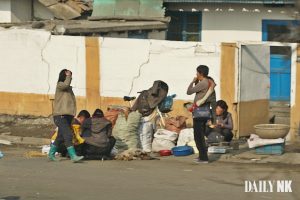Amid North Korea’s attempts to strengthen control over its markets following the closure of the country’s borders last year, the gap between market prices in different regions has been growing more pronounced recently.
Differences in prices between regions in North Korea have steadily decreased as North Korean marketization has created more diverse means of transport. Much of this can be attributed to the increase in North Korean servi-cha, which are vehicles that operate like a taxi or courier service and can traverse the entire country within a single day.
Despite the increase of oil prices due to international sanctions, there has been few gaps between commodity prices in different areas of the country. However, as North Korean authorities tightened their control over travel between different areas of the country following the start of the COVID-19 pandemic, markets – which rely on stable logistics networks to thrive – have suffered.
A source recently told Daily NK that 450 grams of Chinese flavor enhancer was selling for KPW 165,000 at a market in Hoeryong, North Hamgyong Province, on Mar. 25. One kilogram of sugar cost KPW 45,000, while one kilogram of Chinese flour was KPW 28,000.
Before the authorities enforced the border blockade in January of last year, 450 grams of Chinese flavor enhancer sold at the same market for KPW 5,000, while one kilogram of sugar and flour sold for KPW 5,500 and KPW 4,700, respectively.
The upward shift in market commodity prices in Hoeryong becomes more pronounced when compared with other areas of the country.
At Pyongsong Okjon General Market, which is located away from the Sino-North Korean border in South Pyongan Province, sugar reportedly sold for KPW 31,000 per kilogram on Mar. 23, while flour sold for KPW 11,200 per kilogram.
These statistics indicate that Chinese food product prices are 45% to 250% higher in Hoeryong than in Pyongsong.

“After the start of COVID-19 pandemic, the gap between prices in border areas and inland regions has widened,” the source said. “The small number of imported goods [going into North Korea] come in through Sinuiju in North Pyongan Province and are then distributed to major cities like Pyongyang and Pyongsong.”
The North Korean authorities are expanding their control over markets at an accelerating pace. According to the source, “operating hours of official markets [have been reduced to] 2 PM to 6 PM.”
Before authorities enforced the border blockade at the end of January last year, official markets operated between 9 AM and 6 or 7 PM. Authorities significantly reduced operating hours after enforcing the blockade.
Markets operated from 2 PM to 7 PM even during pre-blockade “rural mobilization periods,” which was when the authorities restricted market hours to mobilize local communities to help with farming activities. Operating hours of official markets are even shorter now than they were during those times.
Due to recent lockdowns in Hyesan and Manpo, markets in these areas have gone through dryspells of not being able to open at all.
Commercial activities in areas that share a border with China have also been limited by the enforcement of rotating work schedules, where people work one day and stay home the next.
*Translated by S & J

















